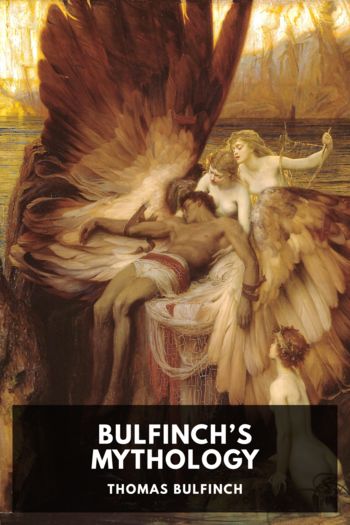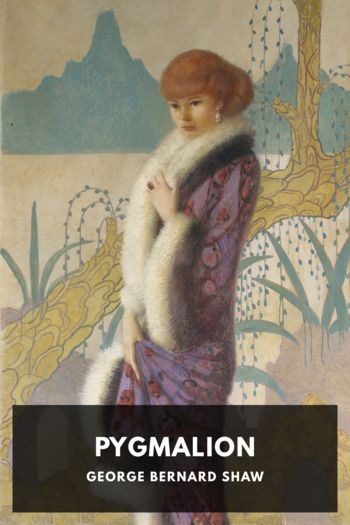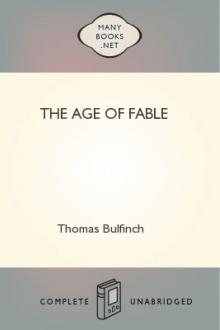Bulfinch’s Mythology, Thomas Bulfinch [love story books to read txt] 📗

- Author: Thomas Bulfinch
Book online «Bulfinch’s Mythology, Thomas Bulfinch [love story books to read txt] 📗». Author Thomas Bulfinch
The stories which have engaged our attention thus far relate to the mythology of southern regions. But there is another branch of ancient superstitions which ought not to be entirely overlooked, especially as it belongs to the nations from which we, through our English ancestors, derive our origin. It is that of the northern nations, called Scandinavians, who inhabited the countries now known as Sweden, Denmark, Norway, and Iceland. These mythological records are contained in two collections called the Eddas, of which the oldest is in poetry and dates back to the year 1056, the more modern or prose Edda being of the date of 1640.
According to the Eddas there was once no heaven above nor earth beneath, but only a bottomless deep, and a world of mist in which flowed a fountain. Twelve rivers issued from this fountain, and when they had flowed far from their source, they froze into ice, and one layer accumulating over another, the great deep was filled up.
Southward from the world of mist was the world of light. From this flowed a warm wind upon the ice and melted it. The vapors rose in the air and formed clouds, from which sprang Ymir, the Frost giant and his progeny, and the cow Audhumbla, whose milk afforded nourishment and food to the giant. The cow got nourishment by licking the hoar frost and salt from the ice. While she was one day licking the salt stones there appeared at first the hair of a man, on the second day the whole head, and on the third the entire form endowed with beauty, agility, and power. This new being was a god, from whom and his wife, a daughter of the giant race, sprang the three brothers Odin, Vili, and Ve. They slew the giant Ymir, and out of his body formed the earth, of his blood the seas, of his bones the mountains, of his hair the trees, of his skull the heavens, and of his brain clouds, charged with hail and snow. Of Ymir’s eyebrows the gods formed Midgard (mid earth), destined to become the abode of man.
Odin then regulated the periods of day and night and the seasons by placing in the heavens the sun and moon and appointing to them their respective courses. As soon as the sun began to shed its rays upon the earth, it caused the vegetable world to bud and sprout. Shortly after the gods had created the world they walked by the side of the sea, pleased with their new work, but found that it was still incomplete, for it was without human beings. They therefore took an ash tree and made a man out of it, and they made a woman out of an elder, and called the man Aske and the woman Embla. Odin then gave them life and soul, Vili reason and motion, and Ve bestowed upon them the senses, expressive features, and speech. Midgard was then given them as their residence, and they became the progenitors of the human race.
The mighty ash tree Ygdrasill was supposed to support the whole universe. It sprang from the body of Ymir, and had three immense roots, extending one into Asgard (the dwelling of the gods), the other into Jotunheim (the abode of the giants), and the third to Niffleheim (the regions of darkness and cold). By the side of each of these roots is a spring, from which it is watered. The root that extends into Asgard is carefully tended by the three Norns, goddesses, who are regarded as the dispensers of fate. They are Urdur (the past), Verdandi (the present), Skuld (the future). The spring at the Jotunheim side is Ymir’s well, in which wisdom and wit lie hidden, but that of Niffleheim feeds the adder Nidhogge (darkness), which perpetually gnaws at the root. Four harts run across the branches of the tree and bite the buds; they represent the four winds. Under the tree lies Ymir, and when he tries to shake off its weight the earth quakes.
Asgard is the name of the abode of the gods, access to which is only gained by crossing the bridge Bifrost (the rainbow). Asgard consists of golden and silver palaces, the dwellings of the gods, but the most beautiful of these is Valhalla, the residence of Odin. When seated on his throne he overlooks all heaven and earth. Upon his shoulders are the ravens Hugin and Munin, who fly every day over the whole world, and on their return report to him all they have seen and heard. At his feet lie his two wolves, Geri and Freki, to whom Odin gives all the meat that is set before him, for he himself stands in no need of food. Mead is for him both food and drink. He invented the Runic characters, and it is the business of the Norns to engrave the runes of fate upon a metal shield. From Odin’s name, spelt Woden, as it sometimes is, came Wednesday, the name of the fourth day of the week.
Odin is frequently called Alfadur (All-father), but this name is sometimes used in a way that shows that the Scandinavians had an idea of a deity superior to Odin, uncreated and eternal.
Of the Joys of ValhallaValhalla is the great hall of Odin, wherein he feasts with his chosen heroes, all those who have fallen bravely in battle, for all who die a peaceful death are excluded. The flesh of the boar Schrimnir is served up to them, and is abundant for all. For although this boar is cooked every morning, he becomes whole again every night. For drink the heroes are supplied abundantly with mead from the she-goat Heidrum. When the heroes are not feasting they amuse themselves with fighting. Every day they ride out into the court or field and fight until they cut each other in pieces. This is their pastime; but when meal time comes





Comments (0)